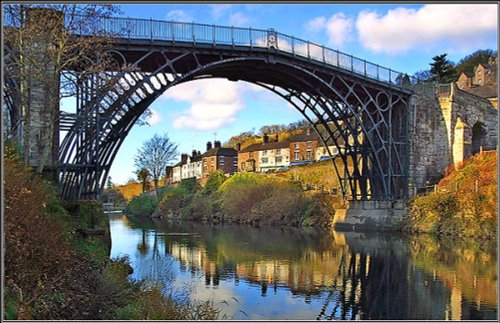Please login or click here to join.
Forgot Password? Click Here to reset pasword

A small riverside town in rural Shropshire seems an unlikely setting for the birthplace of the Industrial Revolution. But Ironbridge, just five miles from Telford, on the River Severn, has an impressive history that belies its small size and remote location.
In the early 18th century, it was discovered that one thing East Shropshire had in abundance was coal. With a seemingly never-ending supply of energy, industry - such as it was at the time - moved in. In 1709 Abraham Darby founded the Coalbrookdale iron foundry, and it is widely acknowledged that it's here that the Industrial Revolution began. Darby initiated major innovations in smelting which resulted in the production of better quality iron much faster than had ever before been possible.
At that time there was no bridge across the River Severn close to the foundry, and the ferry crossing, to carry goods and people, was time-consuming and dangerous, particularly in the winter floods. In 1776, King George III approved an act to build a toll bridge over the river at a point close to Coalbrookdale, about a mile from the foundry. The Iron Bridge was designed by architect Thomas Pritchard and built by Abraham Darby III, using of course Coalbrookdale iron. It was the first bridge in the world ever to be built of cast iron, and its image would become a recognised symbol of the Industrial Revolution.
Once the bridge was in use, a small town began to grow up immediately next to it, and Ironbridge came into existence. Any doubts over the suitability of cast iron for a structure of this size (its single arch spans a distance of about 100 feet) were removed when the bridge survived major floods in 1795. This opened floodwaters of another sort as orders were placed for other iron bridges, aqueducts and buildings.
Today Ironbridge, Coalbrookdale and neighbouring Coalport (home of china and pottery manufacture since the 1750s) are all part of a World Heritage site. The bridge is still there, its graceful arch looking just as it did 225 years ago and there's an exhibition housed in the old tollhouse at the south end of the bridge detailing its history and construction.
In fact you're spoiled for choice when it comes to museums and exhibitions in the area. A good place to start is the Museum of the Gorge, just a fifteen minute walk from the bridge, though longer if you stop for an ice cream from one of the small shops that makes up Ironbridge's main (in fact more or less only) street. This has on display a forty-foot model of the valley as it was at the end of the 18th century, so you can get your bearings.
Although Coalbrookdale is still a working foundry - the famous Coalbrookdale stoves are still crafted there - you can visit the Museum of Iron, see the original furnaces and reservoir systems and walk round old workers' cottages and workshops. For children, the Engenuity centre just next door is a must, with its interactive displays and gadgets to control and drive.
At the Coalport China Museum, a couple of miles away, as well as a bit of a history lesson, there are demonstration workshops and if you don't mind putting on a hard hat, you can go underground and see the naturally occurring bitumen deposits, used in decoration 200 years ago.
There's also Blists Hill Victorian Town, a whole village frozen in time, with everyone in period costume. Houses, shops, a foundry and smallholdings (complete with animals) all exist just as they would have done 150 years ago. As does the village inn, if you're feeling peckish. And if you don't fancy driving round the area, there's a shuttle service that covers all the museums at weekends, and also goes to the nearest mainline railway station, at Telford (fares start at 40p, and you can get a day tickets for £3 for an adult or £1.50 for a child).
When you've had your fill of history, there's a large park by the river, ideal for picnicking. Look across the river and you'll see the huge cooling towers of the Ironbridge power station (now closed). They look more like the kilns you can see in the potteries areas of Stafford than power station chimneys, and seem quite surreal looming above the trees.
Ironbridge and Coalbrookdale are steeped in the past. The ancient local history has been well preserved, from china and ceramic production to cast iron smelting, and it's easy to spend a day going back in time to when Shropshire was a major industrial force.
For information on exhibition opening times and how to get there, see https://www.ironbridge.org.uk/visiting.asp
| Article Title | Author | Date |
| The Prettiest Streets in England | poe | 24th November 2020 |
| 10 of the best villages to visit in the Peak District, England | poe | 28th July 2020 |
| A look at some of the most famous views in England... | poe | 16th May 2020 |
| THE TRIAL OF THE PYX | Paul V. A. Johnson | 19th August 2019 |
| The Best Sandy Beaches in Dorset | poe | 7th June 2016 |
| 20 Of The Best Market Towns In England | poe | 1st June 2016 |
| A Human Heart and a Ghost Story in a Northamptonshire Church | Charles Moorhen | 30th October 2009 |
| Exploring the English Village Churchyard | Charles Moorhen | 29th October 2009 |
| Local Legends - The Basingstoke Burial | poe | 28th February 2008 |
| The Hidden Churches of Somerset | Louise Simmons | 6th February 2008 |